13TH URBAN MOBILITY INDIA CONFERENCE ON “EMERGING TRENDS IN URBAN MOBILITY” ORGANISED ON VIRTUAL PLATFORM-GLOBAL PARTICIPATION OF MORE THAN 1000 EXPERTS
AROUND 60,000 REAL ESTATE PROJECTS & 46,000 REAL ESTATE AGENTS REGISTERED
NEW PARLIAMENT BUILDING TO BE A MODERN ICONIC STRUCTURE TO SHOWCASE VIBRANT DEMOCRACY – TO HAVE A MAGNIFICENT CENTRAL CONSTITUTIONAL GALLERY ACCESSIBLE TO PUBLIC
E-SAMPADA- NEW WEB PORTAL & MOBILE APP LAUNCHED ON GOOD GOVERNANCE DAY-- TO SIMPLIFY PROCESSES & BRING UNIFORMITY IN SYSTEMS ACROSS INDIA &BENEFIT IN ALLOTMENT FOR OVER ONE LAKH GOVERNMENT ACCOMMODATIONS IN 28 CITIES
E-DHARTI GEO PORTAL LAUNCHED TO ENSURE EASE OF LIVING, BRING TRANSPARENCY & ACCOUNTABILITY IN MANAGEMENT OF MORE THAN 60,000 L&DO PROPERTIES
MASTER PLAN OF DELHI 2041 -TO FOSTER A SUSTAINABLE, LIVEABLE AND VIBRANT DELHI
ERP BEING IMPLEMENTED IN CPWD TO ENSURE TRANSPARENCY, EFFICIENCY AND ACCOUNTABILITY
The overall investment in Urban transformation is up by 627% during the last 6 years of 2014-2021 as compared to the period between 2004-2014. The amount spent on creating and upgrading urban infrastructure and ensuring ease of living for the citizens is Rs 12 lakh crore(approx) compared to a mere Rs 1.5 lakh crore during 2004-14. The Missions under the Ministry of Housing & Urban Affairs played a stellar role during the Covid-19 pandemic and implemented several measures to ensure Nation’s fight against the pandemic and ensure ease of living for the citizens.
As a response to COVID-19, soon after the first phase of the lockdown, a revised version of the existing Swachhata-MoHUA App was launched to enable citizens to get their COVID-related complaints redressed by their respective ULBs. The App was relaunched with nine additional categories of complaints specific to COVID-19. Over 1.5 lakh COVID related complaints have been resolved on the App with a resolution rate of 87%.SBM-U successfully organized key events on the virtual platform including Swachh Survekshan 2020 Award Ceremony in August 2020 and the Safaimitra Suraksha Challenge in November 2020.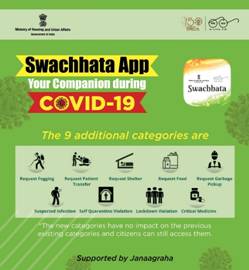
The Smart City Mission ensured that the Smart Cities remained in the forefront in leveraging technology to manage COVID crisis. More than 50 smart cities transformed their Integrated Control & Command Centres (ICCCs) into COVID-19 war rooms to enable collaboration with various government departments dealing with COVID response particularly Bangalore, Pune, Indore, Agra, Varanasi and Surat. A model COVID War room was developed in Bengaluru Smart City in 24 hours. Integrated dashboards were developed in cities of Pune, Agra, Varanasi, Surat, Bengaluru for effective decision-making, monitoring COVID hotspots, medical infrastructure, tracking movement of goods and services and managing lockdown.Smart Cities like Surat, Pune, Nagpur, Agra& Chennai leveraged web-based/mobile applications for contact tracing and also for tracking and monitoring virus infected persons. Smart Cities like Kanpur, Gwalior, Indore and Agra leveraged their ICCCs for two-way communication with dedicated lines for telemedicine and counselling of infected patients.Smart Cities leveraged smart communication infrastructure and Drones to manage lockdown and monitor social distancing in public spaces more effectively.
AMRUT Mission helped in improving public health & hygiene during COVID induced lockdown and around 15 lakh water tap connections and more than 9 lakh sewer connections were provided since lockdown.
PM SVANidhi, a unique scheme for the urban street vendors was launched in June 2020for providing affordable collateral free working capital loan to street vendors to resume their livelihoods that were adversely affected due to Covid-19 lockdown. This scheme targets to benefit over 50 lakh street vendors and provides incentives in the form of interest subsidy @ 7% per annum on regular repayment of loan and cash-back upto Rs. 1,200 per annum on undertaking prescribed digital transactions. On timely or early repayment, the vendors are eligible for loans of up to Rs. 20,000 during the second cycle and up to Rs. 50,000 during the third cycle. An end-to-end solution through an IT platform has been developed in collaboration with Small Industries Development Bank of India. So far, more than 33.6 lakh loan applications have been received. Out of these more than 17.3 lakh loans have been sanctioned and more than 12.7 lakh loans disbursed.
A programme of Socio-Economic Profiling of PM SVANidhi beneficiaries and their families was launched as an additional component of PM SVANidhi Scheme for extending the benefits of various govt Schemes for their holistic socio-economic upliftment. This was based on the vision of Hon’ble Prime Minister that PM SVANidhi scheme should not be seen merely from the perspective of extending loans to street vendors but as an instrument for outreach to street vendors and their families. 125 cities have been selected in the first phase for the programme.
National Urban Livelihood Mission (NULM)coordinated with around 50 thousand SHGs for preparing and supplying about 7 Crore Masks, over 3 lakh liters Sanitizers and 2 lakh PPE kits. The Mission also ensured free supply of 3 meals a day in Shelters for Urban Homeless to over 1 lakh homeless, including migrants.SHGs’also organized community kitchens in 14 States to provide food to about 60 thousand persons each day during lockdown.
In line with Prime Minister's clarion call of 'AtmaNirbhar Bharat', Affordable Rental Housing Complexes (ARHCs) as a sub scheme under PMAY-U was approved to provide ease of living to urban migrants/poor in Industrial Sector as well as in non-formal urban economy to get access to dignified affordable rental housing close to their workplace. So far, 29 States/UTs have signed MoA (Memorandum of Agreement) for implementation of ARHCs. Gujarat and UT of Chandigarh have become first movers by identifying existing Government vacant houses and furthering allotment processes. The UT of Chandigarh has identified 2195 such houses, out of which 1703 have been already allotted to urban poor families. In Gujarat, RFPs have been issued for Rajkot and Ahmedabad whereas concessionaire has been selected for Surat.
Around 20,000 houses under the AHP vertical of PMAY-U were used as COVID facilities. The Credit Linked Subsidy Scheme (CLSS) for Middle Income Group (MIG) under PMAY-U was extended to 31st March 2021 as a measure under ‘AtmaNirbhar Bharat’ initiative. Extension of CLSS for MIG will benefit 2.5 lakh Middle income families mobilising an investment of Rs 70,000 crores in financial year 2020-21.
To ensure that home buyers do not suffer due to any delay in completion of housing projects in the wake of COVID-19 pandemic, MoHUA issued an advisory to all States/UTs and their Real Estate Regulatory Authorities for issue of orders to invoke force majeure clause and extend the completion date ‘suo moto’ or revise / extend completion datefor all real estate projectsregistered under RERA for a period of 6 months, where completion date expires on or after 25th March, 2020 and further for a period upto 3 months, if the situation arising out of COVID-19 so demands.
In spite of the lockdown and suspension of metro rail network in the country, Metro companies including NCRTC (National Capital Region Transport Corporation) continued their work to ensure that the ground work for the construction of metro network can restart as soon as the lockdown was lifted. Pre-bid meetings through VC and contract awarding etc were in progress in various metro rail projects. Various metro companies floated tenders and awarded works for the construction of metro network even during the pandemic. NCRTC issued tenders for Delhi- Meerut RRTS corridor, Uttar Pradesh Metro Rail Corporation awarded tenders for Kanpur and Agra projects. Similarly, DMRC, Bangalore Metro Rail Corporation, Maharashtra Metro, Kochimetro, Madhya Pradesh Metroand Noida Metro Rail Corporation also carried out the preparatory work. The metro companies also formulated Standard Operation Procedures (SOPs) for resumption of metro rail services to contain the spread of pandemic. Based on the SOPs, every metro rail company prepared guidelines for resumption of services after lockdown in a graded manner. Wearing of face mask/cover and ensuring physical distancing has been made mandatory during metro travel.
SBM-URBAN:
SBM 2.0 is being actively considered to make Swachhtha a way of life. The focus over the next five years will be to ensure that all cities of Urban India are certified ODF+ and rated at least 3 Star Garbage Free, and all cities with less than 1 lakh population certified as ODF++. Additionally, 50% of cities with less than 1 lakh population to be Water+ certified. With tremendous achievements during the last six years, the Mission has indeed been able to script a new chapter in the journey towards a Swachh’, Swasth’, ‘Sashakt’, ‘Samridhh’ and ‘Atmanirbhar’ Bharat. The progress in the mission so far: -
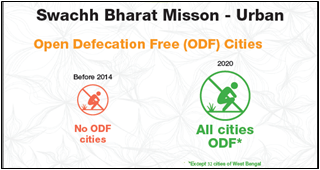 Sanitation: From a position of zero Open Defecation Free (ODF) states and cities in 2014, urban India has become ODF, (except for 12 ULBs of West Bengal).
Sanitation: From a position of zero Open Defecation Free (ODF) states and cities in 2014, urban India has become ODF, (except for 12 ULBs of West Bengal).
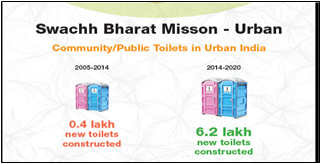 Over 66.5 lakhs individual household toilets have been constructed – exceeding the target of 58.99 lakhs.
Over 66.5 lakhs individual household toilets have been constructed – exceeding the target of 58.99 lakhs.
- Over 6.2 lakhs community/ public toilets have been constructed – exceeding the target of 5.07 lakhs.
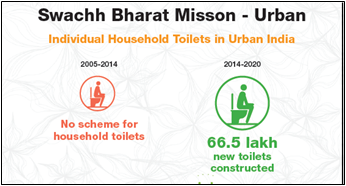 In an effort to promote holistic and sustainable sanitation, the Ministry introduced the ODF+ and the ODF++ Protocols focusing on functionality and usability of community/ public toilets and complete faecal sludge and septage management respectively in 2018. As on date, a total of 1,389 cities have been certified ODF+, and 489 cities certified ODF++.
In an effort to promote holistic and sustainable sanitation, the Ministry introduced the ODF+ and the ODF++ Protocols focusing on functionality and usability of community/ public toilets and complete faecal sludge and septage management respectively in 2018. As on date, a total of 1,389 cities have been certified ODF+, and 489 cities certified ODF++.
- In an effort to make public toilets more accessible to citizens, the Ministry partnered with Google to map public toilet blocks on Google Maps. As on date, over 60,000 toilets across 2900+ cities have been made live on Google Maps (including 500+ toilets covered by National Highway Authority of India) with more toilets being added every day.
- Solid Waste Management-
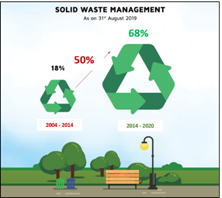
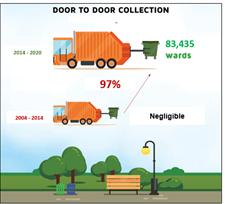 Door-to-door collection and source segregation of waste, which were almost negligible before 2014, now stands at 97% (83,435 wards out of 86,284 wards) and 77% (66,400 out of 86,284 wards) respectively. The percentage of waste processing which stood at 18% before 2014 has grown more than three times over and now stands at 68%. The Star Rating Protocol for Garbage Free Citieswas introduced in January 2018 – a framework to promote holistic and sustainable solid waste management and helping cities to progressively move towards higher levels of cleanliness.6 cities (Mysuru, Navi Mumbai, Surat, Rajkot, Indore and Ambikapur) have been rated as 5 Star, 86 cities as 3 star and 64 cities as 1 Star so far.
Door-to-door collection and source segregation of waste, which were almost negligible before 2014, now stands at 97% (83,435 wards out of 86,284 wards) and 77% (66,400 out of 86,284 wards) respectively. The percentage of waste processing which stood at 18% before 2014 has grown more than three times over and now stands at 68%. The Star Rating Protocol for Garbage Free Citieswas introduced in January 2018 – a framework to promote holistic and sustainable solid waste management and helping cities to progressively move towards higher levels of cleanliness.6 cities (Mysuru, Navi Mumbai, Surat, Rajkot, Indore and Ambikapur) have been rated as 5 Star, 86 cities as 3 star and 64 cities as 1 Star so far.
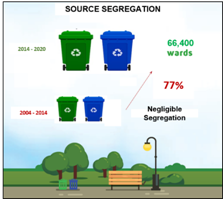 SWACHH SURVEKSHAN
SWACHH SURVEKSHAN
So far5 editions of Swachh Survekshan, have been conducted. The first edition of the survey which was piloted in 73 cities (with million plus population) in 2016 has today grown manifold with 4,242 cities participating in Swachh Survekshan 2020, the fifth edition of the survey.Swachh Survekshan 2021 has been launched with the on-field assessment to be conducted in March 2021. Citizen engagement has been a major component of Swachh Survekshan with participation increasing year on year. The last edition, Swachh Survekshan 2020 witnessed an unprecedented participation of 12 crore citizens.
SAFAIMITRA SURAKSHA CHALLENGE-
SBM-U has launched the Safaimitra Suraksha Challenge (on 19 November 2020) with the objective of preventing ‘hazardous cleaning’ of sewers and septic tanks and promote their mechanized cleaning. The Challenge is presently being undertaken in 244 cities. As part of the Challenge, a dedicated helpline number 14420 has been set up to register complaints on hazardous cleaning and provide real-time solutions on desludging or sewer line overflow. The actual on-ground assessment of participating cities will be conducted in May 2021 by an independent agency and results declared in August 2021.
INTEGRATION AND MAINSTREAMING OF SANITATION WORKERS AND INFORMAL WASTE PICKERS-The Mission has integrated over 84,000 informal waste pickers into the mainstream while over 5.5 lakh sanitation workers have been linked to various welfare schemes under the Government.
Swachh Manch, an online citizen engagement portal to empower stakeholders to volunteer and contribute to the Swachhata of their cities has recorded participation from over 7 crore citizens. SBM-U has over 140+ celebrity ambassadors espousing the cause of Clean India. Some of the key campaigns in 2020 include ‘The Story of Malasur- The Demon of Defeca’ which is the first of its public awareness campaign on the issue of faecal sludge management and ‘Suraksha Nahi toh Safai Nahi’ touching upon the issue of hazardous cleaning of sewers and septic tanks.
DAY-NATIONAL URBAN LIVELIHOOD MISSION
Deendayal Antyodaya Yojana – National Urban Livelihoods Mission (DAY-NULM) works towards alleviating urban poverty through building strong community institutions, providing skill training, access to affordable credit for self-employment, support for street vendors and shelters for the urban homeless. The Mission is facilitating urban poor in creating sustainable livelihoods. There are more than 5.2 lakh Self Help Groups with more than 53 lakh members. So far more than 10 lakh persons have been skill trained/certified and bank loan given to 12 lakh persons. 2,168 shelters have also been sanctioned under the Mission. DAY-NULM aims to issue vending certificates to 50 lakh street vendors, empower 40 lakh urban poor through entrepreneurship development and create City Livelihood Centres in all million plus Smart Cities. The mission also aims to bring 1 crore women under the SHGs by 2024
Atal Mission for Rejuvenation & Urban Transformation (AMRUT)
More than 93 lakh water tap connections and 59 lakh sewer connections under the Mission have been provided so far. By 2023, AMRUT will be able to provide targeted 1.39 crore water tap connections and 1.45 crore sewer connections. Around 15 lakh water tap connections and 9 lakh sewer connections have been providedunder the mission since lockdown. The Mission has ensured development of more than 1,755 green spaces& parks and will add 5,400 acres of green spaces through parks by 2023, thus helping in improvingenvironment and water conservation.
For promoting energy conservation, 80 lakh conventional streetlights have been replaced with energy efficient LED lights leading to energy savings of 175 crore units per annum and reduction in CO2 emission by 14.02 lakh tons per annum. Around 13 lakh streetlights have been replaced with LED lights in 2020.Complete replacement of 1.02 crore streetlights with LED lights is being targeted by 2023.
In order to make cities credit worthy to access market finances, Credit rating work has been awarded for 485 cities and completed in 469 cities. 163 cities have received Investible Grade Rating (IGR), including 36 cities with rating of A- or above. 9 urban local bodies of Ahmedabad, Amravati, Bhopal, Hyderabad, Indore, Pune, Surat, Visakhapatnam and Lucknow have raised ₹3,690 crore through municipal bonds. The ULB of Lucknow has raised municipal bonds worth ₹200 crores in 2020. To incentivise these nine ULBs, ₹207 crore have been released.
To ensure ease of doing business in construction permits, Online Building Permission System (OBPS) withseamless integration with internal/external agencies has been made operational in 2,101 towns including 444 AMRUT cities to facilitate online issuance of construction permits, leading to reduction in compliance costs and time.India’s rank in Ease of Doing Business (EODB)in construction permits jumped to 27 in World Bank’s Doing Business Report (DBR) 2020 from 181 in 2018.
MoHUA is planning a new Jal Jeevan Mission (JJM-U), to cover all the statutory towns with an aim to make them ‘Water Secure’. JJM-U at an estimated cost of ₹2,79,000 crore will promote circular economy of water, including (i) Providing 100% functional tap connections in all urban households by 2026 (ii) 100% sewerage coverage in 500 AMRUT towns by 2026 (iii) Meeting 20% total water demand and 40% of industrial and other non-potable water demand by 2026 from recycled water and (iv) Rejuvenating at least 3 water bodies per city by 2026. This investment is expected to create 84 crore person dayswork over the Mission period.
SMART CITIES MISSION
It’s a transformational Mission for a paradigm shift to change the urban landscape of the country. The ultimate vision is to work towards making all Indian cities Smart. The year 2020 has seen accelerated project implementation with Smart Cities focusing on grounding and completion of projects. Of the total committed investments of ₹2,05,018 crore as per approved Smart Cities Plans, 5,331 projects worth ₹1,76,059 crore (86% of total) have been tendered so far, work orders have been issued for 4,540 projects worth ₹1,39,969 crore (68% of total) and 2,122 projects have beencompletedworth ₹34,986 crore (17% of total).
Transformative projects – key achievements:
- Integrated command & control centres (ICCCs) to help cities in evidence-based smart governance operationalised in 53 cities and in progress in 30 cities. Total investment worth over ₹15,000 crore is planned under the mission.
- Towards boosting urban mobility, smart cities have completed over 250 smart road projects and 415 projects are nearing completion with investments worth over ₹20,000 crore.
- Recognising the need for collaborations/partnerships with private sector to bring efficiencies, 110 PPP projects have been completed and 203 projects are under progress with investments worth ₹22,000 crore.
- With focus on public spaces like river/lake fronts, parks and playgrounds, tourism destinations, 62 vibrant urban space projects have been completed, and 82 projects are in progress with investments worth over ₹8,000 crore.
- Towards making our cities more liveable and sustainable, 85 smart water projects and 46 smart solar projects have been completed. Further, 138 smart water and 36 smart solar projects are in the pipeline.
- Ease of Living Index and Municipal Performance Index: Outcome and performance assessment frameworks to measure quality of life and city performance rolled out in 114 Cities. Over 31 lakh citizens engaged with as part of Citizen Perception Survey.
- The Urban Learning and Internship Program (TULIP) aims to match opportunities in ULBs/smart cities with learning needs of fresh graduates. 284 Smart Cities/ ULBs have posted over 13,000 internships out of which 828 candidates are undergoing internships and 81 have completed their internships.
- DataSmart Cities and Data Maturity Assessment Framework (DMAF) rolled out in 100 Smart Cities to help cities create a data ecosystem for data-driven governance. Second round of annual assessment currently underway. Centre for Digital Governance (CDG) has been established in NIUA.
- ClimateSmart Cities Assessment Framework (CSCAF) rolled out in 100 Smart Cities to help cities look at urban planning and governance from the perspective of climate change.
- India Cycles4Change Challenge, Streets for People Challenge, Nurturing Neighbourhoods challenge are being implemented by the Mission towards scaling-up transformative projects benefitting citizens and contributing to enhanced quality of life.
- New transformative initiatives are being planned such as EatSmart Challenge in association with FSSAI. A Challenge called ‘Tech4Mobility’ is being planned to promote technology in enhancing public transportation.
- The mission has targeted to setup ICCCs in all 100 Smart Cities by 2022.
- DataSmart Cities Strategy will be scaled up in 500 Cities by the end of the Mission.
- Open Data Platform / India Urban Data Exchange (IUDX) shall be enabled in 500 cities under the program.
HOUSING FOR ALL
Prime Minister Shri Narendra Modi on January 1, 2021 set the Nation on course of a new dawn in construction sector. He laid the foundation for six Light House Projects (LHPs) in six States as part of Global Housing Technology Challenge (GHTC). The LHPs will serve as live laboratories for facilitating transfer of technology to the field and its further replication. Mass use of these technologies from across the globe will bring speed, sustainability, resource efficiency, environment friendliness; disaster resilience, quality and durability in structures. The LHPswith allied infrastructure facilities are being initiated at Indore (Madhya Pradesh), Rajkot (Gujarat), Chennai (Tamil Nadu), Ranchi (Jharkhand), Agartala (Tripura) and Lucknow (Uttar Pradesh).Use of globally proven technologies has been the mainstay of speedy delivery of pucca houses under PMAY-U. GHTC–India was launched in January 2019 to create an enabling eco-system to facilitate paradigm shift in the construction technology. 54 proven alternative and innovative technologies have been identified, evaluated through the challenge process under GHTC- India and are being promoted for mainstreaming.
An additional outlay of₹ 18,000 Crore for PMAY-U was also announced in Nov, 2020. It is estimated that investment under PMAY(U) would have created more than 587 Crore person days of employment which translates to creation of about 210 lakh jobs in total (nearly 58 lakhs as direct and 151 lakhs as indirect). It is estimated that more than 591 lakh MT of cement and about 141 lakh MT of steel would have been consumed in the construction of grounded houses so far under PMAY(U). This is proving to be a stimulus for allied industry.
So far more than 1.09 crore houses have been sanctioned under PMAY(Urban). The construction is in different stages in more than 70 lakh houses while more than 40 lakh houses have already been delivered. Under the Credit Linked Subsidy Scheme (CLSS), 13.20 lakh beneficiaries have been funded with interest subsidy of ₹ 30,868 crore. which includes ₹ 10,491 crore for 4.85 lakh beneficiaries of Middle-Income Group (MIG). PMAY-U is propelling an investment which is more than 17 times the investment made earlier in affordable housing program.The success of the Mission can be attributed to its robust financial model of which, Direct Benefit Transfer (DBT) has been a key element. Besides, use of Information Technology for real time monitoring and technological innovation have been salient aspects of PMAY (U).
Angikaar campaign was launched under PMAY-Uto mobilise communities for change management through awareness on best practices such as water & energy conservation, waste management, sanitation and hygiene. 20 lakh households were outreached. ANGIKAAR has now converged with campaigns like Financial Awareness Messages (FAME), EAT Right India in association with Food Safety and Standards Authority of India (FSSAI) and FIT India movement.
URBAN TRANSPORT
Metro Rail Network in the country is operational in 18 cities with a network of approximately 702 kms. The construction work of metro rail/RRTS is presently on in 27 cities. The Approved metro rail network including Regional Rapid Transit System (RRTS) is 1,718 kms. The daily metro rail ridership in the country in Pre-COVID went upto 85 Lakh passengers.Metro Rail Policy 2017was brought in for systematic planning and implementation of metro rail systems and to act as a guide to state governments for preparing comprehensive metro rail proposals for enhancing mobility in cities.
Atma Nirbhartha in Metro rail and transformative reforms: -
- Standardization of all sub systems of metro rail (Rolling Stock, Signaling, Telecom, Civil and Electrical and Mechanical) to promote indigenization and reduce cost.
- Indigenous procurement of metro rail components for which sufficient local capacity is available Alstom, Bombardier, Titagarh and BEML the companies based in India bagged tenders for more than 1,000 Metro and RRTS coaches for metro projects in Mumbai, Pune, Kanpur, Agra and for Delhi-Meerut RRTS corridor.
- Revised minimum local content (on percentage basis) in procurements of metro rail components (Rolling Stock-60%; Tele communication-50%; Signaling-50%; Civil-90% for elevated & 80 % for underground; Electrical & Mechanical – 60%.
- Developed Indigenous Automatic Train Supervision System (iATS) jointly by DMRC and BEL (a PSU of Ministry of Defence) would be used on line-1 of Delhi Metro as a measure to upgrade to signalling system. The indigenous system would also be used in Phase-IV of Delhi Metro system.
- MetroLite: Issued standard specifications for Light Urban Rail Transit System called “MetroLite” in July, 2019 to cater the mobility needs of smaller cities with lower ridership.
- MetroNeo: Issued standard specification for rail guided, rubber tyred electric coaches powered by overhead traction system named MetroNeo in Nov 2020, suitable for smaller cities with lower projection of ridership.
- National Common Mobility Card (NCMC) launched in March, 2019. This initiative will facilitate large scale indigenous production of debit/ credit cards equipment’s compliant to NCMC standards and specifications, and their deployment in Indian transit system. NCMC is fully operationalised on the DMRC’s Airport Express Line since 28December 2020.
- Launched the indigenously developed AFC named ‘Swagat’ in March 2019.Value Capture Finance (VCF) Policy Framework, 2017 - identifies tools for financing infrastructure projects.
Hon’ble PM flagged off the First Fully Automated Driverless Train on Delhi Metro's Magenta Line (Janakpuri West – Botanical Garden) on 28 Dec 2020. DTO will eliminate the possibility of human error and provide more operational flexibility. It will improve services conditions of drivers who will not be required to pick Metro rake from depot at the state of service and also not required to take metro rake upto depot at the closure of metro service.
13TH Urban Mobility India Conference was organised on virtual platform on the theme of “EMERGING TRENDS IN URBAN MOBILITY”.More than 1000 experts participated in the conference.Prof. Jan Gehl, Founder and Senior Advisor, M/s Gehl, Mr Jean-Baptiste Djebbari Minister Delegate for Transport, Ministry for the Ecological Transition, Government of France, Dr. Claudia Warning, Director-General GIZ were the prominent experts who participated in the event.
REAL ESTATE (REGULATION & DEVELOPMENT) ACT, 2016 (RERA)
There was no regulator for the real estate sector in the country for the past 70 years which led to many anomalies resulting in various unfair practices, which ultimately affected the homebuyers adversely. To ensure regulation and promotion of Real Estate Sector in an efficient, transparent and accountable manner and to protect the interest of homebuyers, the Real Estate (Regulation & Development) Act, 2016 (RERA) was enacted. RERA is a transformative legislation which brought discipline, transparency, accountability and efficiency in the sector and thus empowered the home buyers. RERA seeks to address vital issues of fair transactions, timely delivery and quality construction through speedy adjudication of disputes.
So far 34 States/UTs have notified rules under RERA while the state of Nagaland is under process to notify the rules. West Bengal has enacted its own legislation, which has been challenged before Supreme Court and MoHUA has filed its affidavit to annul it. 30 States/UTs have set up Real Estate Regulatory Authority (Regular - 25, Interim - 05). Jammu & Kashmir, Ladakh, Meghalaya and Sikkim have notified the rules while yet to establish Authority. 26 States/UTs have set up Real Estate Appellate Tribunal (Regular -18, Interim – 08). Arunachal Pradesh, Assam, Himachal Pradesh, Jammu & Kashmir, Ladakh, Meghalaya, Mizoram and Sikkim are under process to establish). Around 60,000 real estate projects and 46,000 real estate agents have registered under RERA across the country. Around 60,000 complaints have been disposed-off by the Real Estate Regulatory Authorities across the country.
L&DO & ESTATES – Launch of e-Sampada & e-Dharti portal
e-Sampada portal - In a significant step towards promotion of e-governance, boost transparency and accountability in providing various Estate Services like allotment, retention, regularisation, no dues certificate etc, the Directorate of Estates launched a new integrated Web Portal and Mobile App, e-Sampada. The automated processes will minimize human intervention and lead to greater transparency. E-Sampada equips users with very specialised features like personalised dashboard, service usage archive and real time status on licence fees/dues. The new application provides a single window for all these services including allotment for over one lakh government residential accommodations, office space allotment to government organisations in 45 office complexes in 28 cities, booking of 1,176 holiday home rooms and venues like 5, Ashoka Road for social functions etc.
e-Dharti Geo portal– To ensure ease of living, bring transparency & accountability in the management of more than 60,000 properties, L&DO launched this portal. The portal provides all information related to a property includingdate of allotment, property status, plot area, date of execution of lease deed, details about present lessee, litigation status and map. The certificatebeing provided by the L&DO will enable the lessee of the property to get basic details of his/her property alongwith map showing its location. This measure will also help a prospective purchaser to ascertain the details of the property as well as any suit or proceeding is pending in respect of the property. This measure while benefitting the general public, particularly old aged, ailing and as well as women & widows, will also help in avoiding unnecessary litigations.
In a major relief, the allottees of Government accommodations who were not able to accept/ vacate/change/ shift the allotted accommodation within the prescribed period due to lockdown, the Directorate of Estates took suo-moto steps to mitigate their sufferings and granted one-time relaxation to such affected persons. Suo-moto retention was allowed to allottees up to 30.05.2020 and was further extended till 15.7.2020.In case of officers of Paramilitary forces, who were posted in far-flung areas, retention was extended till 31.8.2020.
Under the Central Vista Master Plan, a new state-of–art Parliament building is being constructed adjacent to the present Parliament, which will not only address the space requirement but will also create a modern, iconic structure to showcase vibrant democracy. The new Parliament building will be part of Legislative Enclave and will be dedicated to the nation during 75th Anniversary of Independence. The design plan includes space for a magnificent Central Constitutional Gallery, which will be accessible to the public. The construction of New Parliament Building will utilize resource efficient green technology, generate employment opportunities and contribute towards AatmaNirbhar Bharat. The building will comply with the highest structural safety standards, including adherence to Seismic Zone 5 requirements and is designed for ease of maintenance and operations. The Development/ Redevelopment of Central Vista is being undertaken with the objective of upgrading Parliament’s space and facilities, consolidating, rationalizing and synergizing government functioning, refurbishing and better equipping the Central Vista Avenue and strengthening cultural institutions in the Central Vista.The Republic Day Parade in January, 2022 will be in the new central avenue.
PREPARATION OF MASTER PLAN FOR DELHI (MPD)-2041
To ensure ease of living and provide urban amenities to the citizens of Delhi, a new master plan for Delhi 2041 is being prepared. The new Master Plan will be people-friendly, easy-to-read and understand, GIS-based and available online for general public.It will also enable stakeholders to know the exact policies/provisions that apply on their lands/properties and simplify the norms related to use premises and activities, flexibility in FAR use, parking requirements and enable flexibility in customising future developments for meeting people’s needs. Extensive stakeholder engagement forms the basis of the Vision for Delhi. Outreach includes schools, universities, RWAs, civil society groups and campaigns (related to child friendly cities, universal access, gender concerns, equity, migrants etc), traders and market associations, environment experts, industry groups, professional bodies, etc.
The vision for Master Plan 2041 is to “Foster a sustainable, liveable and vibrant Delhi by 2041”. The key focus areas will bethe provision of good quality green-blue areas for recreation and leisure, tackle pollution and enhance Delhi’s preparedness for Climate Change impacts. The vision would aim at incentivising new formats like serviced apartments, condominiums, hostels, student housing, worker housing, etc.It is also proposed to have TOD based projects to bring jobs and homes closer to mass transit, comprehensive strategies for improving old and dilapidated areas in the city.
Pradhan Mantri – Unauthorized colonies in Delhi Awaas adhikar Yojna (PM-UDAY)-
To substantiallyimprove the living conditions of more than 40 lakhs people residing in unauthorized colonies, the government has decided to confer ownership rights to the residents of unauthorised colonies in Delhi.The ownership rights will be conferred to more than 10 lakh property holders in 1,731 unauthorised colonies in Delhi. The property owners can now enter into valid property transactions and raise funds from financial institutions. This is expected to trigger massive redevelopment of these unauthorised colonies.This decision was necessitated as the work of regularization of unauthorized colonies in terms of 2008 Regulations, which was to be coordinated by the GNCTD, was not making any headway.
CENTRAL PUBLIC WORKS DEPARTMENT (CPWD)
CPWD has undergone a major digital transformation which have facilitated ease of doing business. ERP is under implementation in Central Public Work Department and is envisaged to be completed in the year 2021 which will ensure transparency, efficiency and accountability in the CPWD. 49 New & Emerging Technologies have been introduced by CPWD by incorporating Specifications and Schedule of Rates-2019. This will substantially reduce carbon footprints and will enhance speed of work, while maintaining control on quality of construction. CPWD has also been restructured by reducing the number of reporting levels from seven to four, simplification of Works Manual (from 459 pages to 54 pages) and revision of SOPs have resulted in expeditious execution of projects with transparency, accountability and responsibility. Online Contractors Enlistment Management System has been launched for making complete registration process online for providing better ease of business to the vendors and faster processing in more transparent manner. CPWD is constructing all new buildings conforming to minimum 3-star GRIHA rating for inbuilt energy efficiency and resource conservation.
PRINTING PRESS
State-of-the-art modern government printing press at Minto Road, New Delhiwill be operationalised in 2021. The other four retained Presses, at Maya Puri andRashtrapati Bhawan (New Delhi), Nashik and Kolkatawill be modernised by monetization of the surplus land available with the Presses. This will lead to a quantum jump in quality and capacity for printing.
***
RJ